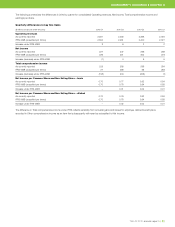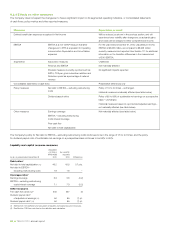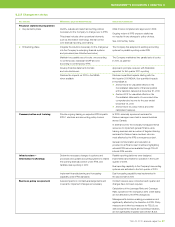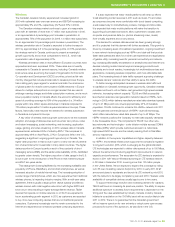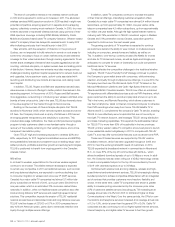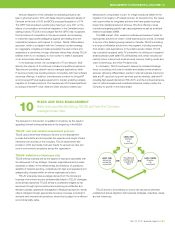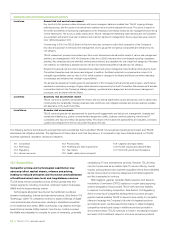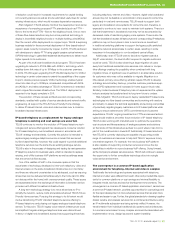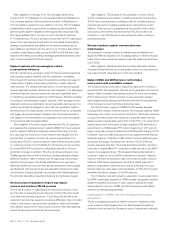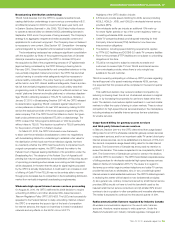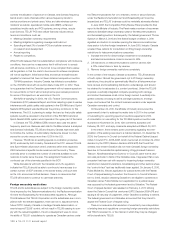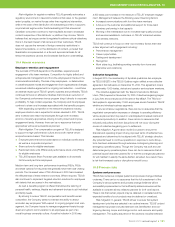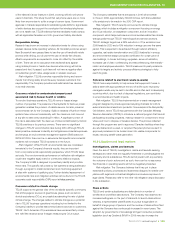Telus 2010 Annual Report Download - page 99
Download and view the complete annual report
Please find page 99 of the 2010 Telus annual report below. You can navigate through the pages in the report by either clicking on the pages listed below, or by using the keyword search tool below to find specific information within the annual report.
TELUS 2010 annual report . 95
MANAGEMENT’S DISCUSSION & ANALYSIS: 10
including telephony, Internet and video. However, digital-only broadband
access may not be feasible or economical in many areas for some time,
particularly in rural and remote areas. TELUS needs to support both
legacy and broadband voice systems for some time and, therefore, is
expected to continue to incur costs to maintain both systems. There is a
risk that investments in broadband voice may not be accompanied by
decreased costs of maintaining legacy voice systems. There is also the
risk that broadband access infrastructure and corresponding IP-telephony
platforms may not be in place in time to avoid some re-investment
in traditional switching platforms to support the legacy public switched
telephone network access base in certain areas, resulting in some
investment in line adaptation in non-broadband central offices.
Additionally, even if TELUS were to decide to migrate towards a
fully IP voice solution, the level of effort required to migrate customers
could be costly. TELUS is also observing a large migration of users
away from traditional residential voice services onto cellular or compe-
titive offerings creating the possibility, when combined with long
migration times, of significant over-investment in an alternative solution
for customers who may not be available to migrate. Migration to a
DSL-based, primary voice offering will also require TELUS to develop
a strategy around battery back-up, proactive customer premises equip-
ment (CPE) replacement and increased in-home support (truck rolls).
Similarly, hosted business IP telephony has not experienced the uptake
industry analysts had predicted and its long-term future is unclear.
Risk mitigation: TELUS continues to deploy residential IP-based voice
technologies into fibre-based communities and is working with vendors
and industry to assess the technical applicability and evolving cost profiles
of proactively migrating legacy customers onto IP-based platforms while
striving to ensure adherence to CRTC commitments and customer
expectations. TELUS’ ongoing investments in FTTN and access technol-
ogies should enable a smoother future evolution of IP-based telephony.
TELUS is also working with manufacturers to optimize the operations,
c
ost structure and life expectancy of analogue systems and solutions
so that some of this infrastructure evolves to a point where it can form a
part of the overall evolution towards IP. Additionally, IP-based solutions
that TELUS is currently deploying are capable of supporting a wide
range of customers and services to help limit TELUS’ exposure to any
one market segment. For example, the new business VoIP platform
is also capable of supporting consumer services and over-the-top
capabilities in addition to a pure business VoIP offering. Going forward,
as the Company’s wireless services evolve, TELUS will continue to assess
the opportunity to further consolidate technology silos into a single
voice service environment.
The convergence in a common IP-based application
environment for telephony, Internet and video is complex
Traditionally the technology and systems associated with telephony,
Internet and video were different from each other and provided little oppor-
tunity for common platforms or cost savings and minimal flexibility to
integrate media, services and service development environments. The
convergence in a common IP-based application environment, carried over
a common IP-based network, provides opportunities for cost savings and
for the rapid development of more advanced services that are also more
flexible and easier to use. Further, the global standards for drawing together
classic wireline and wireless services into a combined architecture using
an IP multimedia subsystem are being actively ratified. However, the
transformation from individual traditional silo systems and architectures
to a common environment is very complex and could be associated with
implementation errors, design issues and system instability.
of adoption could result in increased requirements for capital funding
not currently planned, as well as shorter estimated useful lives for certain
existing infrastructure, which would increase depreciation expenses.
Risk mitigation: TELUS actively monitors the development and carrier
acceptance of competing proposed FTTx standards (such as FTTH –
fibre to the home and FTTN – fibre to the neighbourhood). One or more
of these fibre-based solutions may be a more practical technology to
deploy in brownfield neighbourhoods or multiple dwelling units (MDUs)
than the current xDSL deployments on copper loops. TELUS is exploring
business models for the economical deployment of fibre-based technol-
ogies in areas currently connected by copper. In 2010, TELUS partnered
with developers to deploy FTTH using gigabit passive optical network
(GPON) technology in greenfield residential developments to deliver much
higher speeds to its customers.
As part of its multi-year broadband build program, TELUS has been
upgrading its network to IP DSLAMs with ADSL2+ technology, which
enables down link rates of up to 19 Mbps to the customer premises.
In 2009, TELUS began upgrading this IP DSLAM deployment to VDSL2
technology in certain urban areas to extend the capabilities of the copper
loops to double previous speeds. VDSL2 technology enables typical
down link rates of up to 30 Mbps, is backward-compatible with ADSL
and ADSL2+ and takes advantage of TELUS’ investments in extended
reach copper/fibre access infrastructure. The VDSL2 deployment is
expected to be largely complete in 2011.
The evolution of these access architectures and corresponding
standards, enabled with quality of service standards and network traffic
engineering, all support the TELUS Future Friendly Home strategy
to deliver IP-based Internet, voice and video services over a common
broadband access infrastructure.
IP-based telephony as a replacement for legacy analogue
telephony is evolving and cost savings are uncertain
TELUS continues to monitor the evolution of IP-based telephony tech-
nologies and service offerings and has developed a consumer solution
for IP-based telephony over broadband access in accordance with
TELUS’ strategy and standards. Currently this solution is intended to
replace legacy analogue telephone service in areas that are served
by fibre-based facilities, however, this could expand to provide additional
telephone services over the same line as existing analogue service.
TELUS is also in the process of designing and testing its next-generation
IP telephony solution for business users, which is intended to replace
existing, end-of-life business VoIP platforms as well as address areas
that are served via fibre access.
One of the realities of VoIP in the consumer space is that the
actual state of technology developed to inter-work telephony, video and
Internet access on the same broadband infrastructure is in its infancy
and there are risks and uncertainties to be addressed, such as ensuring
all services can be delivered simultaneously to the home (and to differ-
ent devices within the home) with uncompromised quality. These issues
are exacerbated when the exchange of information is between service
providers with different broadband infrastructures.
A long-term technology strategy is to move all services to IP to
simplify the network, reduce costs and enable advanced TELUS Future
Friendly Home services. Pursuing this strategy to its full extent would
involve transitioning TELUS’ standard telephone service offering to
IP-based telephony and phasing out legacy analogue-based telephone
service. To this point, TELUS’ legacy voice network infrastructure could
be simplified if regular analogue telephone lines were discontinued
in favour of digital-only broadband access lines supporting all services


